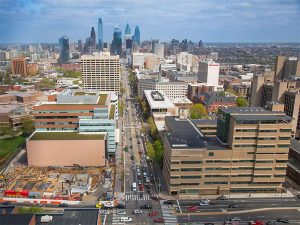Market East “is building this,” and Market East “is improving that.” Wait … Market West?
 |
| Vintage shot of West Market Street, Circa 1925 | Courtesy of PlanPhilly.com |
That’s right, you heard me correctly. Market West is becoming a hot topic within Philadelphia’s development community.
But it’s difficult to say what it could/will look like in the near’ish future.
Over on Market East, projects have already been approved, money is in place, and shovels are in the ground. In other words, there is already a level of certainty that change is happening, and that it’s all positive development (e.g. East Market, Fashion Outlets of Philadelphia, 11th/12th + Chestnut, etc). Plus, we pretty much know what these projects are going to look like when they’re completed; which is comforting.
As for Market West, first of all, who the h*ll even refers to Market Street between City Hall and 30th Street Station as Market West? Well, I guess I just did … and others are too.
Some call it “The Business District,” some call it “Downtown,” and some call it “Rittenhouse” or “Logan Square.” Personally, I’ve always just called it Center City, but today Center City has been split into so many specific pieces/parts due to popular neighborhood names (e.g. Fitler Square, Midtown Village, etc), additions to what is now “considered” Center City (e.g. Fairmount, Graduate Hospital, etc), and the complete separate identity of the ever-growing eds/meds capital of Philadelphia, University City.
So needless to say, you have to be careful with your Philadelphia-neighborhood-based assumptions these days. Otherwise, someone may try to bash you with their Internet muscles.
Over on West Market Street, a big portion of the street frontage has recently become a hot spot for large/proven developers (i.e. those who have a successful track record in Philadelphia, and financial resources to make something happen), who are buying up pieces of real estate as if it were a game of Monopoly: Hey, I just bought my first “color-group” from “the bank,” and I want to start building “houses” and “hotels” (ha, what a great game).
But, why? What’s the draw? What’s the play?
Well for starters, a lot of it was owned by one guy/group/company: Richard Basciano. That name may sound familiar, as it was one his properties that collapsed unexpectedly at 22nd & Market in June 2013. My condolences to anyone/everyone who had a loved one there that day.
Also, Richard has been “speculating” on that long stretch of Philadelphia road for decades, which means he bought low and is now selling high. If you have not read recently, 2015 is a great time to be selling large pieces of Center City real estate.
Finally, large parcels are very hard to come by in Center City these days. Not only for a reasonable price, but just to buy in general. Now that Richard is a willing seller, developers are starting to see this as a great opportunity to close the gap between City Hall and University City. Connecting the two with large anchor projects, which could also spur a building frenzy for smaller projects.
Welp, there you have it. My professional take on one of Philadelphia’s next big development zones. More blog posts will follow, as soon as more news comes out.

